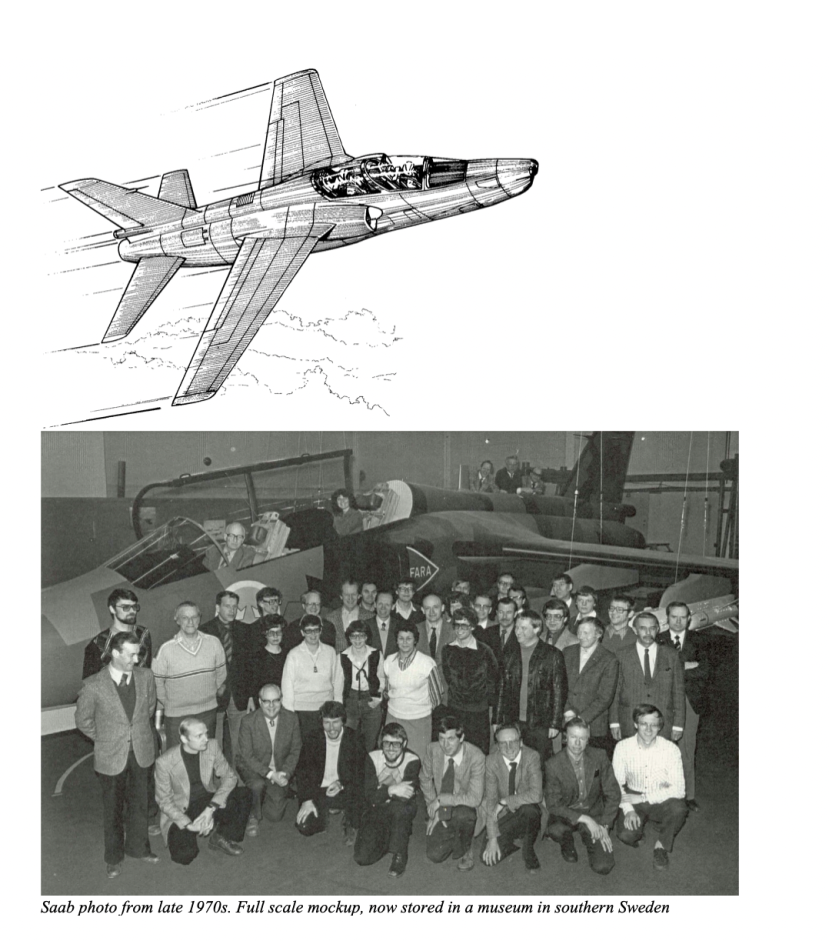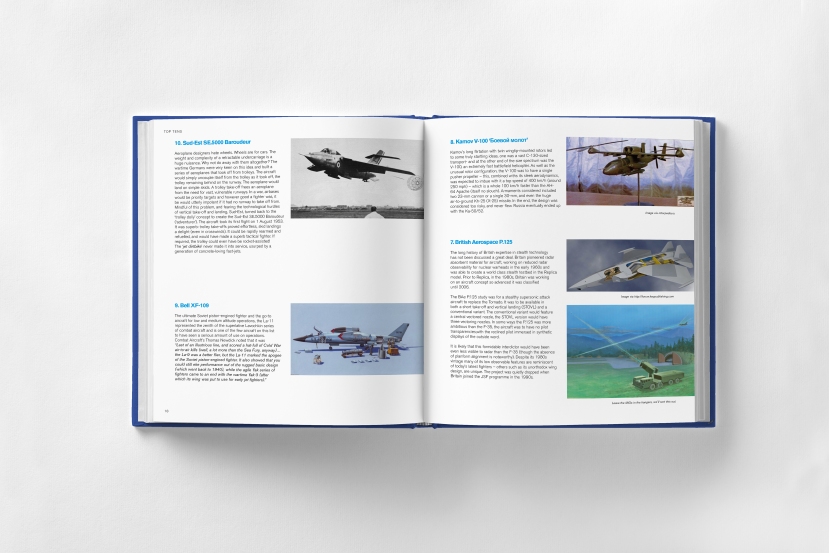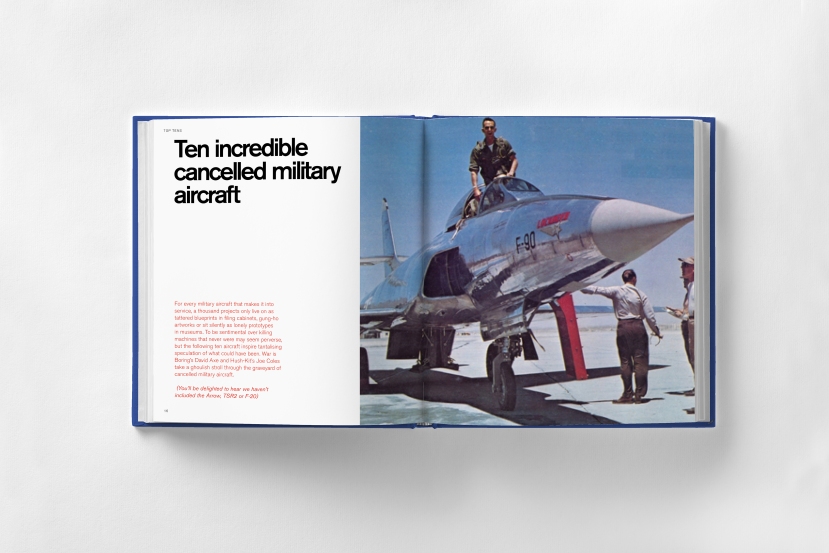Cancelled Swedish combat aircraft projects & the road to Gripen: We speak to Saab’s Knut Övrebö, Chief Engineer of Future Air Systems

A Saab wind tunnel model for a twin-engined supersonic nuclear bomber.
We spoke to Knut Övrebö, Chief Engineer of Future Air Systems for Saab to find out more about the road that led to today’s Gripen mulit-role fighter.
What was B3LA and why didn’t it happen?
“B3LA was a study of a transonic strike aircraft aimed at replacing the ground attack version, AJ 37 Viggen. It was also referred to as the A 38, filling the gap between the Aircraft 37 Viggen and the Aircraft 39 Gripen. (All aircraft destined for Swedish inventory are assigned consecutive numbers including cancelled projects)
B3LA progressed quite far including several wind tunnel tests and a full scale mockup. For a year or so Saab even did some joint work with Aermacchi who was developing the AMX in parallel. But in the late 1970s it was realised that B3LA did not offer enough potential for the future and the focus was redirected into a single multirole platform which could fulfil both Fighter, Attack, and Recce roles. (in Swedish: Jakt/Attack/Spaning, thus JAS 39). Saab had conducted very promising studies of the ‘lightweight fighter concept’ potential, and when B3LA was cancelled in February 1979, the JAS 39 project destined to become the Gripen was initiated. In this process several other options were assessed as well, but I’m not going into such details. A lot is available in books (mainly Swedish) and on the web.”

AMX International AMX
Looking at the respective successes of AMX and Gripen it is not hard to conclude that Saab had the right idea, though AMX is an effective low-cost attack aircraft and did succeed in its relatively modest goals. AMX production ended in 1999 after 200 aircraft were produced. As further testament to that, the Brazilian AMX force is set to be completely replaced by the new generation Gripen…in 2032!


Saab photo from late 1970s. Full scale mockup, now stored in a museum in southern Sweden
Sadly, this site will pause operations in June if it does not hit its funding targets. If you’ve enjoyed an article you can donate here.
The British connection

Around 1980, British Aerospace was looking for a partner for its P.106 concept. It wished to use cutting-edge technologies, including fly-by-wire control and a carbon fibre wing, to offer a viable alternative to the correctly predicted commercial dominance of the F-16. The F-16 had great potential, and was being aggressively promoted by the US, but there was room in the market for another combat aircraft for nations not wishing to sacrifice the advantages of maintaining some indigenous design and production capabilities. Sweden was looking for a Viggen replacement at the time, and Saab was interested in learning more about the P.106. The BAe P.106 was also a canard delta of similar configuration to the nascent Gripen. In the early 80s, a technical exchange between Saab Linkoping and BAe Warton enabled engineers to talk and share ideas. The P.106 effort was led by Jim Fletcher, who had led the Short SC.1 VTOL test aircraft project of the 1960s. Saab decided to pursue JAS 39 Gripen as a national effort, but was impressed by the British carbon fibre wing design. In 1982 it issued a contract with BAE for six sets of wings for the Gripen prototype aircraft. Bae and Marconi-Elliot was also brought in to help resolve early problems with the flight control system.

P.106 was similar in configuration to the JAS 39 Gripen, differences included a cranked leading- and trailing edges to the wing. BAe planned to use an upgraded Turbo Union 199, which likely would have been an inferior choice for a fighter to the F404 selected by Saab for the Gripen.

What, if any, was the influence of BAe P.106 on the Gripen design?
“None that I’m aware of. The P106 looks very similar to the Gripen, but at the same time Israel developed the Lavi and Switzerland were considering the Piranha, both single engine canards. So it’s rather a logical layout for such a configuration.
Gripen was actually the result of extensive exploration of configurations including wind tunnel testing and analysis of all major options. WT-testing of early Gripen was conducted mainly in Rockwell facilities in the US. And one of the options considered (config 2111) was based on Rockwell’s HiMAT-technology (High Manoeuvring Technology). And this alternative has the strongest resemblance to P106. I guess BAe were testing out similar ideas being inspired by Rockwell as well. Below is the Gripen development path with the major configurations assessed during the concept phase from 1979 up until 1982. The Viggen heritage is apparent and a strong point in the final selection of configuration.”
Interview with a Viggen pilot here
Interview with a Gripen pilot here

Enter a caption
What were the Swedish/British fighter talks about in the 1970s and how much did they influence Gripen?
“In this business ‘everybody talk to each other’ quite frequently, and Saab had dialogues with several other industries including collaborative technology studies. I’m not aware of these specific talks you refer to and the influence they had on either side. In the 70s UK seemed to be more focused on VTOL, but later on got into the studies of agile fighters. They did the Jaguar FCS testbed, just as FCS was demonstrated on the Viggen ESS testbed by Saab. There may have been collaboration on technology development such as carbon composites, but I really don’t know. But BAe had a stake in the wing design of the Gripen based on their knowledge within carbon composites.”
When and why was the canard delta arrangement decided upon for Gripen?
See the family tree above. Both tail and canard configurations with various intake positions and planforms were assessed, and the final selection was made in 1982. The rationale for canard was mainly short field performance and air-to-air combat agility: Gripen was to be able to operate from short roadstrips and was designed to excel in air-to-air combat. Furthermore, FCS enabled pitch instability in a canard which gave great weight savings, smaller actuator loads and more agility. In hindsight, this has proven to be a very wise selection. With another configuration, the Gripen would have been bigger, heavier and more draggy requiring a bigger engine to provide similar performance. And then it wouldn’t have been as competitive.
I understand a large twin-engined replacement for Viggen was considered, what was this? “Low operating cost has always been essential to Saab and the Swedish Air Force, and this is directly related to both size and the number of engines. In fact it was the escalating operation and support cost of Viggen that was the main driver for replacing it. The replacement was to provide similar or superior performance at half the weight (size) of the Viggen. And this rules out both twin engines and large aircraft. In the end Gripen is about half the empty weight of Viggen and immediately was vastly superior in all air vehicle aspects. And early on in service the Gripen systems matured into capabilities beyond the most recent fighter Viggen. The only large twin engine Saab concept I can think of was a nuclear bomber being considered in the 1950s. A wind tunnel model is on display at the Air Force Museum in Linköping. But this never progressed beyond an idea.”

Furthermore our air force always assess options to indigenous designs, and I believe the F-4 Phantom II was considered as alternative to the Viggen early on, just as the Northrop F-18L (landbased version of what later became the MDD F/A-18 Hornet) was considered as alternative to Gripen. And both of these were twin-engined large aircraft and would have been very costly to operate.”
What was the SAAB Project 1642-06 FLP Klass B3LM and was it based on the A-10?

“See answer 5. It was clearly inspired by the A-10, but never progressed beyond 3-view sketches. But this is how concept work is often conducted. By ‘reverse engineering’ the competitors, you assess their pros and cons to check if there is something to carry further. And this sketch is typical of such competitor assessments.”
What future fighter studies are Saab doing?

“Future studies are ongoing continuously. We always look beyond the horizon to assess options, to develop technologies and to prepare roadmaps to position ourselves to be highly competitive long term. Studies include future development of existing products and ideas of new products. But I’m not at liberty to reveal information on any of these studies.”
Were any stealth fighter designs considered in the 70s/80 or 90s?
“Stealth design in terms of reducing the radar cross-section by several magnitudes was not considered until the 1980s.”
A Draken pilot I spoke to said Draken had a very low radar cross section – is this true and how low was it? “No it’s not true. Draken has a planform that could be associated with a stealth aircraft, and Lockheed Martin apparently considered acquiring one of the Drakens available in the US to be used as a testbed for UCAVs. Their F-16XL has a remarkably similar double delta planform but was not stealthy either. To acquire low RCS, a suitable planform is not enough. It is down to detail design, surface joints, air intakes, canopy, external stores, etc.
The level of RCS in Draken? I’d say conventional, i.e. comparable with other small fighters of this generation like Mirage III. In other words, in clean configuration without external stores it would have somewhat lower RCS than a large fighter carrying external stores.”
“If you have any interest in aviation, you’ll be surprised, entertained and fascinated by Hush-Kit – the world’s best aviation blog”. Rowland White, author of the best-selling ‘Vulcan 607’
I’ve selected the richest juiciest cuts of Hush-Kit, added a huge slab of new unpublished material, and with Unbound, I want to create a beautiful coffee-table book. Pre-order your copy now right here

This book can only happen with your support. Preorder your copy today here.

From the cocaine, blood and flying scarves of World War One dogfighting to the dark arts of modern air combat, here is an enthralling ode to these brutally exciting killing machines.
The Hush-Kit Book of Warplanes is a beautifully designed, highly visual, collection of the best articles from the fascinating world of military aviation –hand-picked from the highly acclaimed Hush-kit online magazine (and mixed with a heavy punch of new exclusive material). It is packed with a feast of material, ranging from interviews with fighter pilots (including the English Electric Lightning, stealthy F-35B and Mach 3 MiG-25 ‘Foxbat’), to wicked satire, expert historical analysis, top 10s and all manner of things aeronautical, from the site described as:
“the thinking-man’s Top Gear… but for planes”.
The solid well-researched information about aeroplanes is brilliantly combined with an irreverent attitude and real insight into the dangerous romantic world of combat aircraft.
FEATURING
- Interviews with pilots of the F-14 Tomcat, Mirage, Typhoon, MiG-25, MiG-27, English Electric Lighting, Harrier, F-15, B-52 and many more.
- Engaging Top (and bottom) 10s including: Greatest fighter aircraft of World War II, Worst British aircraft, Worst Soviet aircraft and many more insanely specific ones.
- Expert analysis of weapons, tactics and technology.
- A look into art and culture’s love affair with the aeroplane.
- Bizarre moments in aviation history.
- Fascinating insights into exceptionally obscure warplanes.

The book will be a stunning object: an essential addition to the library of anyone with even a passing interest in the high-flying world of warplanes, and featuring first-rate photography and a wealth of new world-class illustrations.





“when B3LA was cancelled in February 1979, the JAS 39 project destined to become the Gripen was initiated. In this process several other options were assessed as well, but I’m not going into such details. A lot is available in books (mainly Swedish) and on the web.”
Looks like a very suitable subject for an future article.
You might have been to unspecific in your quest for RCS for Draken, only information I ever seen was about head on…
Regarding the comment about the F404 engine preferred for the derivative RM12 oer the RB199. The Turbo Union design is lighter , shorter and in-spite of a higher BPR has a smaller diameter.
the RM12 increased the thrust 12100/18100 and reduced the BPR to 0.311 ( range wasnt really an issue for Sweden). Presumably the BPR of the RB199 could have come down as well and there is scope for weight to go up with increased thrust. but may have needed more development .